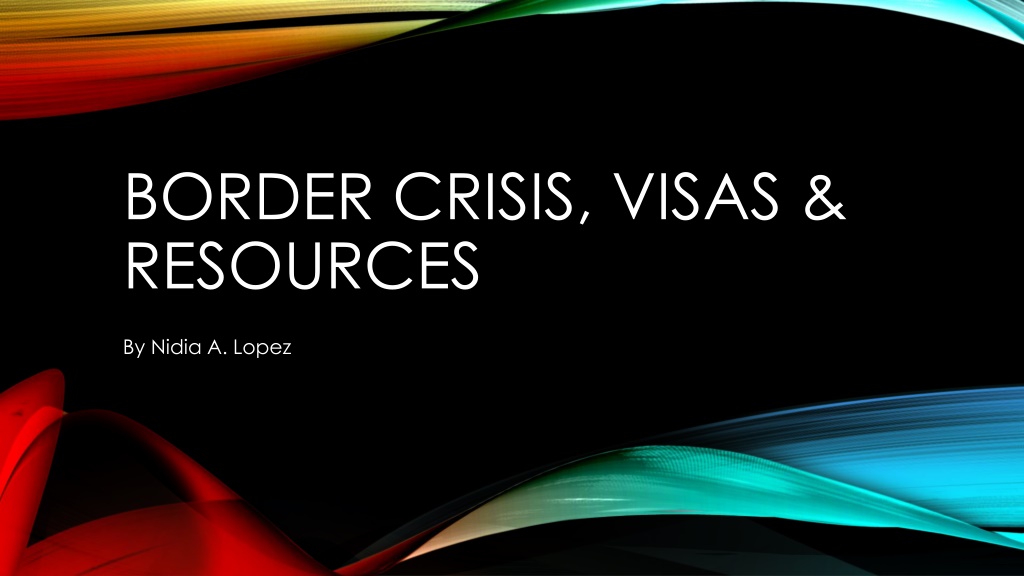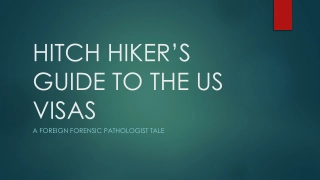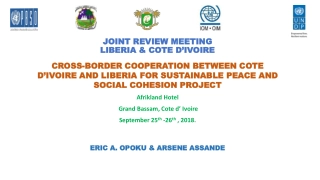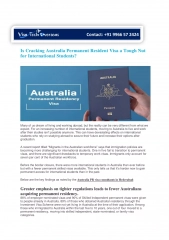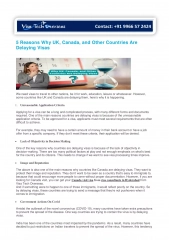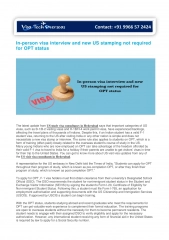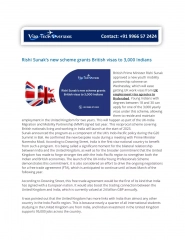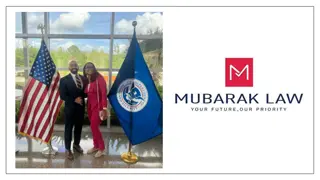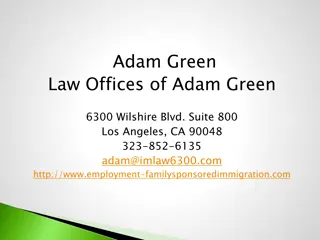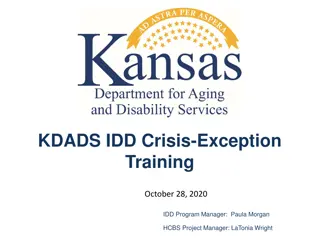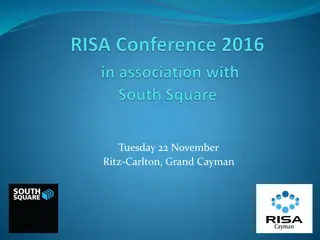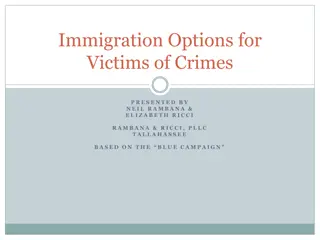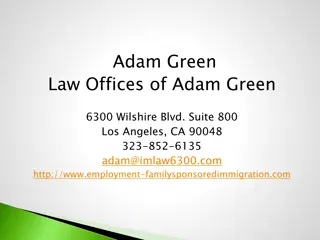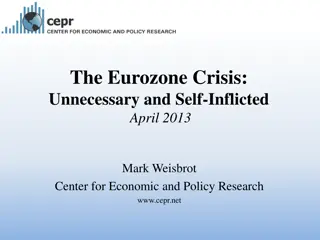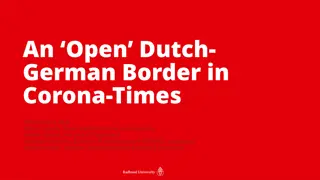Understanding the Border Crisis, Visas, and Resources
Explore the complex issues surrounding the border crisis, visas, and resources in the United States. Learn about the differences between refugees and asylum seekers, controversial policies like Title 42 and the Remain in Mexico policy, and the current challenges and developments in immigration policies. Discover the eligibility categories for visas and green cards, including special provisions for victims of abuse under the Violence Against Women Act (VAWA).
Download Presentation

Please find below an Image/Link to download the presentation.
The content on the website is provided AS IS for your information and personal use only. It may not be sold, licensed, or shared on other websites without obtaining consent from the author. Download presentation by click this link. If you encounter any issues during the download, it is possible that the publisher has removed the file from their server.
E N D
Presentation Transcript
BORDER CRISIS, VISAS & RESOURCES By Nidia A. Lopez
REFUGEE VS ASYLUM SEEKER A refugee receives permission to come to the U.S. from outside of the country. Refugees are resettled with the help of a refugee resettlement agency. These people already have refugee status by the time they arrive in the USA. They are legally allowed to remain An asylee is already in the U.S. when s/he applies for protection. Asylees must prove that they have reason to fear persecution in their home country. (these people are seeking asylum in the United States
WHAT IS TITTLE 45 ? Became law March 20, 2020, issued by the CDC. Mass migrant expulsion order under a legal provision that came to be known as Title 42. Allows border patrol agents to expel people without allowing migrants to apply for asylum. Health order but it s not really about COVID-19. Several States have sued to keep Tittle 42 . On Dec. 27, 2022, US Supreme Court ordered the Biden Administration to continue enforcing the policy .
REMAIN IN MEXICO POLICY Became law via a Memorandum on January 25, 2019. Department of Homeland Security orders asylum seekers to wait in Mexico through the duration of their case in US immigration courts. Officially ended June 2022. Created instability to millions of asylum seekers, displaced migrants.
THE CRISIS AT THE BORDER Title 42 expelled about 2.5 million migrants, most legal annalist predict will end soon. Remain in Mexico policy officially end, displaced migrants in various parts of Mexico. Immigration backlog hits an all time high. Hearing for an immigration hearing, including asylum seeking. Child Migrant apprehensions increased in 2022. Temporary Protective Status (TPS) convers new countries. Amained national labor shortages, foreign worker visa program expands. Refugee admission target rate were set at 11,411 in FY2021. Set at 125,000 admissions cap for FY2023.
VISA GREEN CARD ELIGIBILITY CATEGORIES
VISAS FOR VICTIMS OF ABUSE VAWA (Violence Against Women Act) self-petitioner victim of battery or extreme cruelty The abused spouse of a U.S. citizen or lawful permanent resident The abused child (unmarried and under 21 years old) of a U.S. citizen or lawful permanent resident The abused parent of a U.S. citizen Special Immigrant Juvenile Are a child who has been abused, abandoned, or neglected by your parent and you have SIJ status An abused (victim of battery or extreme cruelty) spouse or child under the Cuban Adjustment Act The abused spouse or child of a Cuban native or citizen An abused (victim of battery or extreme cruelty) spouse or child under Haitian Refugee
VISAS FOR HUMAN TRAFFICKING AND CRIME VICTIMS Complied with any reasonable request for assistance in the investigation or prosecution of acts of trafficking. Suffer extreme hardship involving unusual and severe harm. Under 18 years of age at the time of the trafficking. victims of certain crimes who have suffered substantial physical or mental abuse. helpful to the investigation or prosecution of the criminal activity.
WHAT IS DACA? DACA, an acronym for Deferred Action for Childhood Arrivals Established by Executive Order during the Obama administration 2012 800,000 young people known as DREAMers who entered the United States unlawfully as children. Does not grant official legal status or a pathway to citizenship. Does allow them to apply for a driver s license, social security number, and work permit. Does not allow DREAMers to leave the country.
DACA REQUIREMENTS Entered the United States unlawfully prior to their 16th birthday Have lived continuously in the United States since June 15, 2007 Were under age 31 on June 15, 2012 (born on June 16, 1981 or after) Were physically present in the United States on June 15, 2012, and at the time of making their request for consideration of deferred action with U.S. Citizenship and Immigration Services (USCIS) Had no lawful status on June 15, 2012 Have completed high school or a GED, have been honorably discharged from the armed forces, or are enrolled in school
YOU CANT JUST APPLY ANDGET IN LINE. There s not a line (application category) for everyone. Some people may have no route to lawful immigration status. 4 big lines (application categories), often years long, with many mini lines within Family members of US citizens or lawful permanent residents Highly skilled workers or business investors Painful past (asylum, crime victims, victims of human trafficking, domestic violence) Worldwide Visa Lottery
FEDERALLY QUALIFIED HEALTH CLINICS Serve an underserved area or population Offer a sliding fee scale Provide comprehensive services (either on-site or by arrangement with another provider), including: Preventive health services Dental services Mental health and substance abuse services Transportation services necessary for adequate patient care Hospital and specialty care
FEDERALLY QUALIFIED HEALTH CLINICS are more likely to offer services to undocumented individuals as they receive funding for underserved populations. They may offer sliding scale fees based on income. Advocates may assist individuals who work for cash, to prove income by writing a letter for the clinic to review. This can be a simple statement detailing hours worked per week and gross income. Undocumented individuals often avoid seeking medical or mental health services due to the cost associated or the fear that they will be identified by a government agency. Advocates should work to reassure individuals to seek these resources when necessary. Serve an underserved area or population Offer a sliding fee scale Provide comprehensive services (either on-site or by arrangement with another provider), including: Preventive health services Dental services
QUESTIONS ? NIDIA A . LOPEZ NIDIALOPEZ929@GMAIL.COM 417-529-4178
